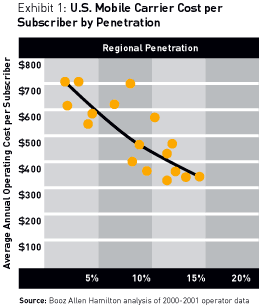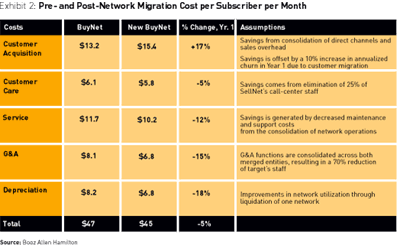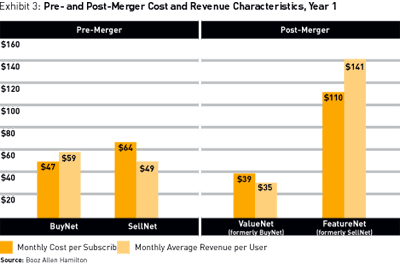Consolidation: The Wireless Way
As pressures to merge rise yet again, wireless operators need innovative approaches to yield economic benefits.
(originally published by Booz & Company)
 |
|
Illustration by Peter Kramer |
The industry landscape has been reshaped by multibillion-dollar acquisitions and ambitious partnerships that produced powerhouses Verizon Wireless Inc., a combination of Bell Atlantic and GTE’s domestic wireless operations on the East Coast and Vodafone AirTouch’s U.S. wireless businesses on the West Coast; Cingular Wireless, a joint venture between SBC Communications Inc. (formerly the Southwestern Bell Corporation) and the BellSouth Corporation; and T-Mobile USA Inc. (formerly the VoiceStream Wireless Corporation), essentially a portfolio of regional wireless companies that became a major mobile presence after being bought by Deutsche Telekom AG. These deals were primarily cross-regional, a way for carriers to combine complementary regional network coverage so they could offer competitive, broad-based calling plans. And while this was going on, Sprint PCS Group and Nextel Communications Inc. were quietly transforming themselves into nationwide networks by gobbling up huge amounts of spectrum through the federal government’s auction of cellular bandwidth. The upshot: There are now six national wireless companies — AT&T Wireless, Cingular, Nextel, Sprint PCS, T-Mobile, and Verizon Wireless. And instead of a carrier or two, 75 percent of the U.S. now can choose from five or more cellular network operators.
But with the cellular marketplace radically redrawn, wireless companies are facing a disturbing truth: Aggressive expansion has produced an unstable and untenable business environment. After a period during which market penetration ballooned — at the end of 2001, cellular companies had signed up 45 percent of the U.S. population, doubling their subscriber base in just four years — growth is slowing. Analysts estimate that at best, U.S. penetration of cellular will reach only about 60 percent in 2005. With a half-dozen national carriers chasing fewer untapped customers, and the ever-present possibility of losing existing subscribers to rivals offering a better deal — about 35 percent of cellular customers change carriers each year — cellular companies are locked in a no-win round of price wars. They’re liberally giving away “free minutes” and discounted handsets to entice new subscribers, and lowering rates for existing subscribers, including the highly profitable heavy users. As a result, the average monthly bill for mobile phone customers has dropped about 8 percent, to $61 at the end of 2001 from $66 in 2000, according to J.D. Power and Associates.
To extricate themselves from this hammerlock, we believe cellular companies will begin a second wave of consolidation. Unlike the prior approach to consolidation, which involved companies’ adding markets by buying carriers or spectrum in new regions, the next wave will be distinguished by carriers’ acquiring competitors, large and small, within their regional service areas. The end game is a return to a relatively balanced oligopoly led this time by large, national carriers that will offer pricing stability and reduce customer churn.
The problems that wireless carriers are being forced to address are not unique to these companies. Commoditization pressures (which are partially the result of overexpansion, a surfeit of companies chasing fewer customers, less demand than anticipated, and overoptimistic market forecasts) have also left many retailers; manufacturers of appliances, personal electronic devices, and computers; and service companies such as airlines mired in distressing business environments. In many cases, consolidation to eliminate competition will be the only way for these companies to stem revenue erosion and dwindling profit margins, as well as to trim operational costs. In fact, such deals have already begun to occur. Consolidation was the driving force behind Hewlett-Packard Company’s acquisition of the Compaq Computer Corporation, its rival in the crowded and increasingly unprofitable PC market; eBay Inc.’s purchase of PayPal Inc., an electronic payment company that was siphoning customers from the online auctioneer’s own digital money service; and the acquisition of the Budget Rent a Car Corporation by the Cendant Corporation, which already owned the more upscale Avis Rent A Car System Inc.
For these companies, and those that will be involved in numerous other acquisitions to reduce competition over the next few years, tough decisions made during consolidation are critical to success. For starters, companies must think about how to integrate technology, how to retain customer loyalty, which products to continue to offer and which to shelve, and what the overall branding and business model should be for the newly merged organization. Simply put, the winners will be distinguished from the losers not merely by consolidation but by the way in which they consolidate. For that reason, the wireless industry, whose commoditization problems are among the most clear-cut in corporate America, presents one of the best examples for analysis of how to thrive when competitive consolidation is the only real option.
Four Goals, Two Hurdles
Cellular phone carriers hope to gain four key strategic outcomes necessary for the long-term success of the wireless industry from the next phase of consolidation:
 • Economies of Scale. Mobile network operators with the highest share of customers within a region benefit from having the lowest costs per subscriber, according to a Booz Allen Hamilton analysis. For instance, in 2001, the average annual operating cost per subscriber for a carrier with 15 percent regional market share was about $350, and double that for a wireless company with about 2.5 percent penetration. (See Exhibit 1.) These significant economies of scale are driven primarily by the large fixed component of local radio network deployment and operating costs.
• Economies of Scale. Mobile network operators with the highest share of customers within a region benefit from having the lowest costs per subscriber, according to a Booz Allen Hamilton analysis. For instance, in 2001, the average annual operating cost per subscriber for a carrier with 15 percent regional market share was about $350, and double that for a wireless company with about 2.5 percent penetration. (See Exhibit 1.) These significant economies of scale are driven primarily by the large fixed component of local radio network deployment and operating costs.
• Reduced Competition. A decrease in the number of carriers in each region will lead to reduced price competition, lower customer acquisition costs, and less churn, all of which are key drivers of profitability. If current industry conditions were to persist, average revenue per customer would continue to drop, and drop even more precipitously, as carriers signed up, at lower prices, marginal customers who would use their cell phones infrequently. Consequently, controlling price erosion, acquisition costs, and competitive churn will become increasingly important for wireless companies.
• Stronger Bargaining Position. Larger carriers are able to exert greater influence on other companies in the value chain. For instance, dominant operators can gain greater “shelf space” for their devices in crowded retail distribution channels, or establish favorable partnerships with technology vendors to test, launch, and reap the rewards of emerging mobile data applications.
• Solutions to Spectrum Scarcity. Leading national carriers are facing spectrum constraints in a significant number of markets, which limits their ability to migrate to new, more advanced network platforms. For carriers lacking spectrum, consolidation could be one of the few solutions. This shortage is being driven in large measure by rapid growth (25 to 40 percent per year) in usage per subscriber, which is increasing as the rates that customers pay for wireless access fall and as companies offer teasers, like “free” unlimited calls on weekends, to entice potential customers who haven’t yet been motivated to purchase a cell phone. Although the federal government is currently scrambling to find spectrum, it is clearly having a difficult time. The anticipated auction of the 700 megahertz (MHz) band, which has been postponed repeatedly, is now scheduled to be completed in early 2003. In addition, litigation has delayed the redistribution of spectrum won in a 1996 auction by NextWave Telecom Inc., which failed to come up with money to pay for the licenses.
Though regional consolidation is obviously necessary for cellular companies to be successful, some companies with overlapping footprints have in the past been dissuaded from merging because of two fundamental obstacles. For starters, to encourage competition, the Federal Communications Commission prohibited any carrier from owning more than 55 MHz of spectrum in any market. Since most of the large national carriers own at least 30 MHz in many of the top markets, this regulation, in effect, has prevented sizable carriers in most regions from merging. This constraint is being eliminated, however, as the FCC plans to phase out spectrum caps completely in January 2003.
The second obstacle is more intractable. It’s virtually impossible to simply and inexpensively integrate overlapping networks. Configuring a cellular network to run seamlessly using switches from different vendors, as well as multiple legacy customer databases, subscriber authentication systems, and billing platforms, can require enormous labor and maintenance resources and take years to fully accomplish. As a result, combining two existing networks after a regional merger is unlikely to yield significant scale-related cost savings (one of the major reasons carriers would be motivated to merge in the first place) for a long time.
Still, carriers shouldn’t view this hurdle as a reason to shy away from the next wave of cellular consolidation. We have identified two consolidation approaches for wireless companies that sidestep the network merger problem, offering the potential to unlock real value while still maintaining a high quality of service.
Scenario 1: Network Migration
What if, instead of integrating two networks, the acquirer migrated the entire customer base of the carrier it purchased onto its own network and closed down the acquired network? This approach is analogous to the switchover from analog to digital cellular phone systems, an arduous task that numerous U.S. carriers have completed successfully.
To illustrate the benefits of this “swallow up” approach, we created a hypothetical example in which BuyNet, a large national carrier, acquires SellNet, a smaller operator. BuyNet has 20 million subscribers and SellNet has 7 million in their overlapping networks, and the two companies have a common communications technology platform (e.g., TDMA/GSM or CDMA). A merger of the two companies would create a powerful No. 2 wireless carrier in the region with a market share of about 22 percent. (All of the numbers used in our analysis of wireless mergers are based on the financial performance of actual companies that are similar in size to the hypothetical carriers described in this article.)
By eliminating SellNet’s network, the new BuyNet could cut the total cost per subscriber per month in the first year by about 5 percent, from $47 to $45. (See Exhibit 2.) The slight size of this initial decrease is the result of a 10 percent increase in subscriber churn likely during customer migration, which would offset significant savings from customer support and network maintenance functions, as well as reduced overhead costs. However, by the fifth year, as customer churn levels return to normal, the lower cost structure resulting from the merger should yield as much as a 10 percent reduction in annual operating expense per subscriber from premerger levels.

In addition, by Year 5 these cost savings would translate into a nearly 50 percent higher EBITDA for the combined company than what BuyNet’s and SellNet’s would have been if the merger had not occurred. The merger should also generate substantial capital-expenditure savings because once subscribers are all on a single network, SellNet’s network could be turned off, eliminating maintenance and upgrade costs. By our analysis, the merged entity’s capital expenditures in Year 5 would be approximately 20 percent lower than without the deal. Because of improvements in EBITDA and capital expenditures, the new BuyNet’s cash flow should turn positive after just over one year.
By contrast, if BuyNet had not acquired SellNet — and, thus, never integrated their networks — it would have taken at least two additional years for the combined cash flow of these separate companies to go into the black.
This network migration scenario presents some challenges, however, including:
• Controlling risks in migrating customers from one network to the other. For instance, subscribers might need new handsets or might experience some technical glitches during the switch to a single network. This could increase churn among affected customers.
• Making sure that billing systems are rescaled to accommodate added volumes while supporting new functionality and uniform rate plans and promotions.
• Accommodating new products on the surviving network, which might not be able to support the same full set of services and features provided by the eliminated network.
• Maximizing the value generated from breaking up the acquired company and redeploying and disposing of the dismantled network assets.
Scenario 2: Two Distinct Networks
An alternative to the network migration scenario is to use the networks of the acquiring and acquired carriers to create two separate operations serving two distinct markets:
• ValueNet (formerly BuyNet) would be a low-cost network for price-sensitive, low-value customers. It would be marketed as a voice and short-message service, with inexpensive pricing programs and minimal customer service.
• FeatureNet (formerly SellNet) would be a high-quality network for high-value customers, typically the individuals and businesses that spend the most per month on cellular phone service. This unit of the newly merged company would provide best-in-class voice and data services supported by extremely responsive customer service.
Both of the new networks, FeatureNet and ValueNet, would become focused operations whose cost basis more closely matches the revenue potential of its subscribers. As shown in Exhibit 3, FeatureNet’s monthly cost per subscriber would likely rise sharply from $64 to $110, largely because it would have a smaller, more exclusive customer base of heavy users than it did when it was SellNet. Plus, the high-end services FeatureNet would provide its customers are expensive to develop and maintain. But FeatureNet’s monthly average revenue per user (ARPU) should also rise dramatically, to $141 from $49, because its customers, lured by its state-of-the-art voice and data services, would be spending more time and money on the wireless network. Meanwhile, ValueNet’s monthly ARPU would drop to $35 from $59, and its monthly cost per subscriber would fall as well, from $47 to $39 — mainly because the new no-frills network would be inexpensive to run and would have low subscription rates.

According to our analysis, the dual network approach would generate positive cash flow in the third year of the new company’s existence, nearly two years earlier than if the acquisition had not taken place. Although part of this cash-flow improvement stems from overall reductions in operating expenses, the main portion of it comes from lower capital expenditures, which would be 25 to 30 percent less than if the companies hadn’t combined. In particular, ValueNet’s capital costs would be cut back significantly because it would focus only on maintenance of the existing network and minimal capacity increases, while forgoing investment in 2.5G/3G upgrades.
Like the network migration approach, the dual business model strategy is not without its obstacles. The following are questions BuyNet’s management team must consider:
• How do we assign existing customers to each business model? What kind of framework for customer segmentation should be used to determine which customers go where? What are service level/feature richness trade-offs?
• How do we tailor the marketing, sales, and channel strategy to deliver each of the two different value propositions? How do we develop these separate and customized business streams while leveraging scale and minimizing costs of functions that are common to each?
• How do we determine which network should be selected to support each of the two business models?
• What level of investment in each of the networks will be needed to reach the target cost position while providing the right features and quality of service?
These two distinct consolidation approaches for mobile carriers unlock considerable value for shareholders, well beyond traditional, less carefully plotted consolidation strategies. But more than anything else, these models for competitive consolidation illustrate a vital point that executives at companies in many industries must keep clearly in mind as they pursue growth by acquiring rivals. If cost savings, innovative approaches to profitability, and new avenues for revenue growth are not constantly monitored and maximized during the acquisition, the company could end up in a worse position than it was in before the deal was made. However, if these factors are diligently considered — following a framework and thought process similar to the one we used in planning the two alternative approaches for wireless mergers — not only will the winners stand out among the many companies whose mergers have failed, but the financial rewards will likely be dramatic. ![]()
Reprint No. 02405
The authors would like to acknowledge Mark Melford (melford_mark@bah.com) and David Tusa (tusa_david@bah.com), who originally developed these approaches to wireless consolidation in the European telecommunications market.
| Authors
Raul L. Katz, katz_raul@bah.com Raul L. Katz is a vice president with Booz Allen Hamilton's New York office. He had 18 years of experience specializing in business strategy, consumer and industrial marketing, and the management of international telecommunications companies. Maximilian E. Weise, weise_maximilian@bah.com Maximilian E. Weise is a senior associate in Booz Allen Hamilton’s New York office. He specializes in developing and implementing strategies for telecommunications service providers and technology vendors. Daniel H. Yang, yang_daniel@bah.com Daniel H. Yang is an associate with Booz Allen Hamilton in New York. He specializes in developing and implementing strategies for wireless and wireline telecommunications carriers. |


